THE ADELPHI
 |
HW’s contributions to The Adelphi to July‒September 1948
HW as owner and editor of The Adelphi, 1948‒9
Subsequent history of The Adelphi
HW was a contributor to this prestigious literary 'little magazine' over many years and became its owner/editor for a brief period ('"little magazine" is a term referring to a set of literary periodicals published between roughly 1912 and 1939 that are characterized by their small readership, financial fragility, and artistic innovation' – Oxford Research Encyclopaedia of Literature).
The Cambridge Guide to Literature (Cambridge University Press, revised edition, 1992) has the following short entry for the magazine:
Adelphi, The A journal founded by John Middleton Murry in 1923, appearing monthly at first and then from 1927 as a quarterly (under the title of The New Adelphi until 1930). Its purpose was chiefly to air the literary and philosophical views of Murry himself and of his friend D. H. Lawrence. Murry handed over the editorship in 1930 to Max Plowman and Richard Rees. Before it ceased publication in 1955 it had counted W. H. Auden, T. S. Eliot, George Orwell and W. B. Yeats among its contributors.
It omits to mention that in the late summer of 1948 HW took over this magazine as owner and editor, albeit for three issues only; neither is he mentioned as a regular contributor. As this is an important episode in HW's life, it is worth recording the total picture of his association with this influential literary magazine.
Also see AW, 'The West Wind Blows Again', in Words on the West Wind: Selected Essays from The Adelphi (ed. John Gregory, HWS, 2000; e-book 2013), which reprints the more important of HW's contributions together with other items that have a connection to him.
A fuller background to John Middleton Murry and HW's association with him can be found in HWSJ 35, September 1999, AW, 'Millennium Revelations', pp. 38-66: followed by an appraisal by Dr Wheatley Blench of Murry's essay on HW, reprinted from The Aylesford Review, Vol. 11, No. 6, 1959. Suffice to state here, to explain the remark in the Cambridge Guide to Literature, that John Middleton Murry and his wife, the writer Katherine Mansfield, were very close friends of D. H. Lawrence and his wife Frieda von Richthofen. The four had lived in a ménage-à-quatre in Cornwall until Lawrence had to leave the country at the outbreak of the First World War.
John Middleton Murry (1889‒1957) was a man of great integrity and intellectual ability, and a prolific writer. Murry was a pacifist, but worked in the Ministry of Information for the duration of that war. During the Second World War he ran the famous 'Community Farm' at Thelnetham near Diss, in Norfolk.
The Cambridge Guide to Literature is also slightly misleading, for Murry retained ownership and was the named editor of the magazine until he handed it over to HW: thus Max Plowman and Sir Richard Rees were 'sub-editors' rather than editors. During the Second World War this role was undertaken by J. P. Hogan.
The entry here will fill in details not covered elsewhere about HW's actual articles and connected items (which are shown in bold). James Farrar’s name appears several times: for a more detailed consideration of his work, see the dedicated page for his collected works, The Unreturning Spring.
*************************
HW’s contributions to The Adelphi to July‒September 1948:
HW's first (short) contribution was at a very early stage of the magazine:
Vol. II, No. 4, September 1924:
HW, 'The Doom of the Peregrine Falcon'


('The Doom of the Peregrine Falcon' was reprinted in Words on the West Wind: Selected Essays from The Adelphi.)
HW was himself still in the earliest stage of his writing career. His fourth book, The Peregrine's Saga, had appeared in November 1923. After this short piece there was then a long gap before he made any further contribution to the magazine, which came during the Second World War, when HW was running the Norfolk Farm, and had made contact and become personally friendly with Middleton Murry.
***************
Vol. 19, No. 4, July–September 1943:
HW, 'Fare Thee Well, My Poesy' ('Fare thee well' as meaning 'Goodbye')
HW working on the Norfolk Farm thinks back to his beloved Devon:
Sometimes I think, with the momentary illusion of poetic vision, How can Devon, my Devon, get on without me: [or rather] How can I get on without Devon?
The essay is an adroit mixing of the hard work of the Norfolk Farm and the idyllic Utopia of Devon.
***************
Vol. 20, No. 1, October–December 1943:
Adrian Bell, 'In Answer to Henry Williamson', pp. 7-9 (i.e. to 'Fare Thee Well, My Poesy')
Bell's own ideas on the subject. Adrian Bell, writer and farmer, and friend of HW, lived near Beccles on the Suffolk/Norfolk border.
HW, 'The Tragic Spirit', pp. 17-19 (This essay was first published in two issues of the Eastern Daily Press a little earlier in the year. It is collected in Green Fields and Pavements: A Norfolk Farmer in Wartime, HWS, ed. John Gregory, 1995; e-book 2013.)
HW had listened from his hospital bed (recovering from appendicitis) to Noel Coward, broadcasting 'as a national figure' songs and poems to the Forces. HW's thoughts include:
the passing of a thousand and more heavy bombers across the Norfolk coast was like the final scene in Götterdämmerung itself.
His thoughts go back to the First World War and (almost inevitably one feels) Wilfred Owen, and then to Hitler (fallen from the grace of that previous war): 'History will endorse what he wrote of others [quoted earlier in the essay] in 1919 to be his own indictment twenty years later.' This shows that HW was fully aware that his former admiration of the man was misjudged.
***************
Vol. 20, No. 2, January–March 1944:
HW, 'Seven Years After'
Changes noted from first seeing the Norfolk Farm.
***************
Vol. 20, No. 3, April–June 1944:
HW, 'Prospect and Retrospect', pp. 79-82
Having been writing a book – now finished – 'the eighth or ninth revision of a present-time chronicle' (i.e. the sequel to The Story of a Norfolk Farm) our author decided on the last day of January to go for a walk along the edge of the marshes. During this he manages to fit in the story of one of his children saving his younger brother (see The Children of Shallowford). This is another 'before and now' essay, but here covering the beauty of nature and decadence of man. One cannot write about beauty in the midst of war – and he ends by quoting Wilfred Owen: 'All the poet can do today is warn.'
***************
Vol. 20, No. 4, July–September 1944:
HW, 'The Harvest in the Corn Hall', pp. 124-129
Here he relates the story of the Oswald Mosley meeting (named here as 'Birkin' as in the later A Chronicle of Ancient Sunlight, while Lady Downe is 'Sunne') at King's Lynn in Norfolk at the end of 1938, an episode well described in The Phoenix Generation (Chapter 14, 'Birkin for Britain'). This early use of the noms-de-plume, as in his journal manuscript, is interesting.
Also of interest in this issue: on the back cover is an advertisement for books published by Andrew Dakers, HW's first agent, who had decided to set up his own publishing company. The books include: J. Middleton Murry, Adam & Eve: An Essay towards a New & Better Society; and Bridge into the Future: Letters of Max Plowman (who had been an editor of The Adelphi in the 1930s).
***************
Vol. 21, No. 1, October– December 1944:
HW, 'Withypool, June 1940', pp. 33-36 (reprinted in HWSJ 35, September 1999, pp. 69-72)
HW tells of a walk taken by him and the artist Alfred Munnings, who had a house in Withypool on Exmoor, Devon. A seemingly pleasant interlude in HW's nature lyric style, but he ends it harshly: 'A week later I was in prison having been arrested on my return to Norfolk under Regulation 18B.'
There are two problems here: first – HW was never in prison (he spent a weekend in Wells Police Station); and second – the walk actually took place on 22 September 1938. In 1940, before he was temporarily arrested, HW was working hard on the farm! HW later adapted this article to form a scene in the last volume of his Chronicle of Ancient Sunlight, The Gale of the World.
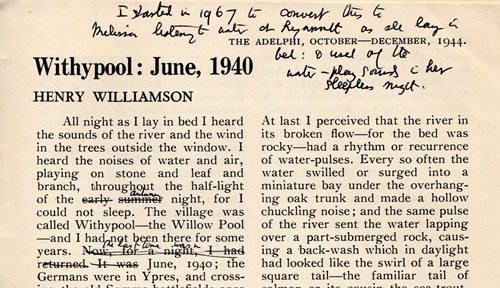
HW's note at the top of the page reads:
I started in 1967 to convert this to Melissa listening to water as she lay in bed: & used only the water-play sounds in her sleepless night.
In The Gale of the World this lovely passage describing the sounds of the river through the night is extended to a complete page (p. 292).
Also of interest: the same Dakers advertisement is on the back cover; while on the inside of the back cover is an advertisement for Faber books which gives an insight into farming and country books of the time. HW is well represented but A. G. Street takes the prize!

***************
Vol. 21, No. 3, April–June 1945:
HW, 'A Walk in Spring', pp. 130-34
A tale in the style of his early 'Village' books (nature-lyric): a walk on the North Devon coast (Baggy Point) with his fear of the cliff height – with village characters and behaviour regarding a donkey thrown down a well-shaft to get rid of it: moral.
On the back cover a full page advertisement for HW's The Sun in the Sands (Faber, March 1945):

***************
Vol. 21, No. 4, July–September 1945:
HW, 'Village Children of the 'Twenties', pp. 179-185
The familiar story of Ernie, son of Revvy Carter (HW's adjoining neighbour when he lived at Skirr Cottage, Georgeham in the early 1920s), and the 'sheep's nose' apples.
***************
Vol. 22, No. 1, October–December 1945:
HW, 'A Crown of Life', pp. 36-44
This is dedicated 'for Benjamin Britten': HW had become aware of Britten's music at this time and had approached him with an idea of writing the music for a proposed film of Tarka the Otter.
First printed in Nash's Magazine (December 1935), then the US magazine Atlantic Monthly in January 1936, and collected in Tales of Moorland & Estuary (Macdonald, 1953), this is a magnificent short story about Clibbit Klifft, again of the Georgeham era, gradually including his most faithful dog, Ship. Clibbit is imprisoned for a misdemeanour not his own fault, and later unhappily shoots himself. The dog grieves and disappears. The climax comes when the dying dog comes into the church during the Christmas Day service and creeps up to the communion rail, where the Rector blesses it:
'Be thou faithful unto death; and I will give thee a crown of life.’ . . . The sun shone through the eastern window, where Christ the Sower was radiant.
It is a very poignant story. (The bible quotation is from Revelations, Ch. 2, v. 10. Swinburne uses the phrase in his Dolores, 1866.)
A Faber advertisement on the back cover includes Tales of a Devon Village (September 1945):
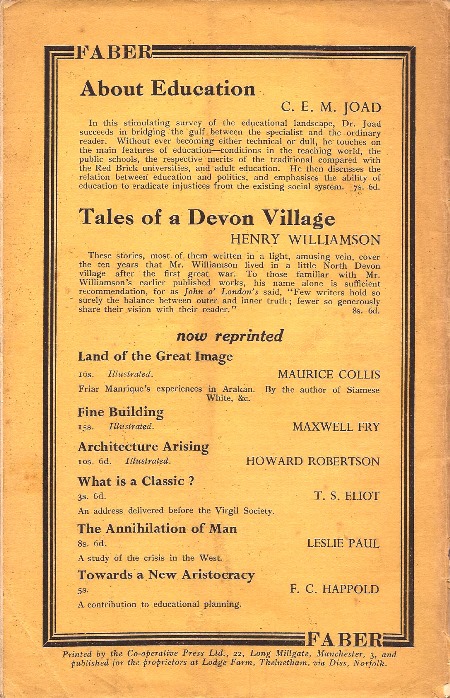
***************
Vol. 22, No. 2, January–March 1946:
HW, 'The Sun that Shines on the Dead', pp. 72-79
This article contains material from The Wet Flanders Plain (1928), recounting the visit HW made to the First World War battlefields when on his honeymoon in 1925, and a further visit in 1927.
***************
Vol. 22, No. 3, April–June 1946:
HW, 'The Sun that Shines on the Dead II', pp. 130-33
A continuation of the battlefields visit, ending rather hauntingly with words of Richard Jefferies:
What you seek is lost forever in ancient sunlight, which arises again as Truth.
This issue also has a story by James Farrar: 'Hayfield' (reprinted in Words on the West Wind). Flying Officer James Farrar, of 68 Night Fighter Squadron, was killed in action while acting as navigator of a Mosquito piloted by Fred Kemp on the night of 25/26 July 1944, when, on patrol over the Thames, they were ordered to intercept a V1 flying bomb. He was just a few weeks short of his 21st birthday.
***************
Vol. 22, No. 4, July–September 1946:
HW, 'Farming Story', pp. 186-88
An artist painting a peaceful pastoral scene on a farm is contrasted with the farmer at war with his work getting in the harvest. They each think the other is lucky and that their own work is harder than that of the other. It is a nicely-put and well-presented argument.
***************
Vol. 23, No. 1, October–December 1946:
It was this issue of The Adelphi that contained (from HW's viewpoint) James Farrar's all-important 'The Imagination to the Wraith', a short prose item addressed to the 'Wraith': Willie Maddison of the Flax of Dream novels – and thus HW himself.
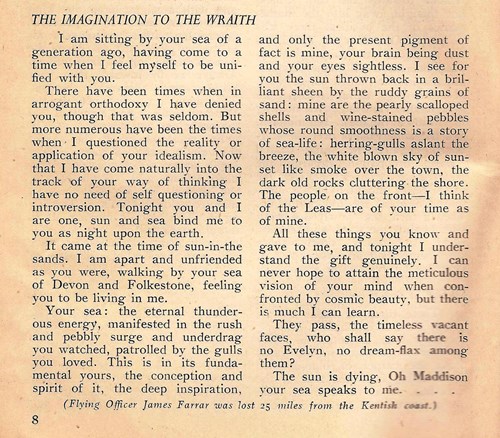
HW does not give the date that this was written, but Christopher Palmer, in his Spring Returning: A Selection from the Works of James Farrar (1986), notes that it was 'Spring, Torquay, 1942.
One can imagine the shock HW must have felt on reading that: shock and then – what? – a profound emotion of empathy, of recognition of a like mind, a soul-mate? October 1946 saw HW at a very low ebb, as is shown in other entries in 'A Life's Work' covering this period (see particularly The Phasian Bird). War – death – loss – were foremost in his mind as he struggled to come to terms with the situation in the world and in his personal life. Unfortunately there is no copy of this particular issue in HW's archive, as there is no doubt that he would have written some comments in situ. It was sent to young Sue Connolly (Malcolm Elwin’s step-daughter, with whom at the time HW was enamoured).
However, the effect of Farrar's work on HW can be seen by the comments he wrote in his copy of the next issue of The Adelphi, which contained Farrar's essay 'Pale Blue Windows'. The realisation that someone had read his work and believed in him as a writer gave him back his faith in himself as a writer.
***************
Vol. 23, No. 2, January–March 1947:
HW, 'From A Wartime Norfolk Journal: Easter 1944', pp. 96-7 (reprinted in HWSJ 36, September 2000)
This powerful piece of writing is an important example of HW's thinking as he uses 'Easter' and its symbolism as a metaphor for the current situation: countries at war. It is essential reading for anyone wishing to understand HW's thinking.
This issue includes the essay by James Farrar, 'Pale Blue Windows'.
HW's file copy has a note on the front cover:

He also wrote at the head of the article by James Farrar:

It reads:
"When I died, I brought back the angels to you, dear Henry Williamson" says James Farrar. The calmness in my writing, the sense of eternity, came with this poet's death.
H.W. July 1947, in the hut.
***************
Vol. 23, No. 3, No. 4, and Vol. 24, No. 1 all contain poems by James Farrar.
***************
Vol. 24, No. 2, January–March, 1948:
HW, 'From 'A Chronicle Writ in Darkness', pp. 101-108
This is an extract from the journal that HW kept that he intended to be the sequel to The Story of a Norfolk Farm (1941), and which eventually became Lucifer before Sunrise (Vol. 14 of A Chronicle of Ancient Sunlight).
This extract covers Christmas 1941, the family and life on the farm at that time. It contains an important passage about his thoughts on Tolstoy's War and Peace. Altogether this is an important essay giving an insight into HW's thoughts. However, the article caused a rift between HW and Murry together with the then sub-editor J. P. Hogan. HW kept altering his article, to the point of holding up production of the issue, to the total exasperation of the Adelphi pair. Murry wrote a strong letter 'in sorrow and anger', complaining that HW knew very well how difficult things were with the magazine and how important it was to get it out before Christmas (see HWSJ 35, September 1999, p. 57). But he also says that he hopes this criticism will not make any difference to their valued friendship – and it did not.
This issue also includes a long and objective review of Oswald Mosley's The Alternative by J. M. Murry, Murry himself being a great thinker and a pacifist. It is an excellent analysis of this (to most people) controversial book.
***************
Vol. 24, No. 3, April–June 1948:
HW sent a copy of Murry's review of Mosley's book (as above) to Mosley himself, and here, (having gained his permission) introduces Mosley's letter of reply to himself, printed under the heading: ‘Mosley on Style’. Mosley seemed to think Murry had criticised his 'style' and defends himself. That seems a little churlish in view of Murry's very fair review – in which any such criticism is not apparent. It would however be a just criticism, for The Alternative is so obtuse in style that it is very difficult to read!
***************
Vol. 24, No. 4, July–September 1948:
The following must have been quite a bombshell to Murry's faithful subscribers:

HW, 'Birth of the Phasian Bird', pp 199-205 (reprinted in Words on the West Wind)
This is an extract from The Phasian Bird (Faber, November 1948) – soon to be published; but curiously the book itself is given no mention.
This issue also contains a poem by the West Country poet Charles Causley (as indeed do several past issues). Causley, whose superb work has never really received the recognition it deserves, was a friend of HW. Causley was made a CBE in 1986 and a Royal Society of Literature Companion of Literature in 2000. He died in 2003. There is a Charles Causley Trust, whose purpose is to keep alive his memory and promote writing in the community and region in which he lived.
***************
HW as owner and editor of The Adelphi, 1948‒9:
This 'bombshell' came about thus: HW had made a visit to London from 30 April to 4 May 1948 and, probably while delivering his article for this next issue of The Adelphi, he learned from J. P. Hogan that Murry was giving up the magazine. There is nothing whatsoever recorded in his archive about this, but evidently HW made an offer to take on the magazine himself. F. A. Lea, in Life of John Middleton Murry, merely states that Murry gave the magazine away – but frustratingly gives no further details!
Ann Thomas noted in HW's diary, Wednesday, 5 May (the day after HW's return) that:
HW acquires the ADELPHI by phone.
Presumably that was with Murry himself. The same day she approached the Chronicle Press in Ilfracombe (then printing A Braunton Guide, to which HW had contributed 2 articles, 'The Burrows 1938' and 'Baggy Hole, Revisited in 1945'), asking if they could print and supply paper for 5,000–10,000 copies of a quarterly magazine – the title is not mentioned.
There were then approaches to various publishers over the next few days to get quotations for printing the magazine: Macdonald, Dick de la Mare at Faber, and finally Stevens in Malvern, who were actually given the job. HW stated at some later point that he took over The Adelphi in order to give Ann a job that would make her independent. I think it has to be presumed that at this time they were not actually getting on very well. HW had written a 'despairing' letter to Murry the previous month which may have been about this (Murry's answer was very supportive: 'Dear man, I am perfectly certain that it can't be as bad as you imagine . . .’), and HW may have seen this as a solution to the problem. Ann could return to her own cottage near Malvern, and run the magazine from there, leaving him free.
HW probably did not realise just how difficult and involved such a project would be. There was an enormous amount of work involved, and although Ann did all the basic work, the overall responsibility still lay with HW. Apart from the actual physical properties of paper and printing, there was a big need to collect paid advertisements, which would contribute greatly with the running costs. There are several notes of HW visits to London to solicit these. As important, articles also had to be sought – and edited.
There is no note of when Ann returned to Malvern, but her notes in HW's diary cease in the middle of July: there is little mention of her after that. The reason for this is that it is now that HW met Christine Duffield, who called in at the Field while on a walking tour with her brother, presumably at the beginning of the school summer holidays – so, at the end of July. (Christine was either already teaching at a school in nearby Croyde, or was to start there that September.) The result: another headlong falling in love – and, quite quickly, marriage. Ann Thomas (then approaching 40, while their daughter was aged 15) was totally ousted. She continued to work on The Adelphi during the short time that HW remained its owner and editor, but it was a very bitter blow, for she had presumed that if HW remarried, it would be to herself.
***************
Vol. 25, No. 1, October–December 1948:

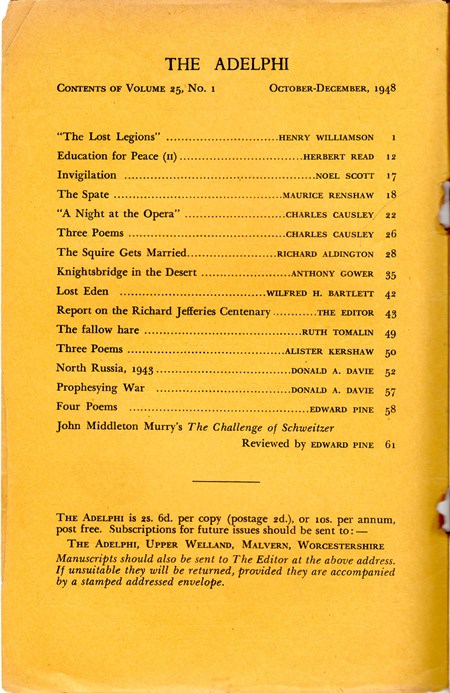
HW launched his first Editorial: “The Lost Legions” (reprinted in Words on the West Wind)
He explains that the title came from an essay by John Middleton Murry that he had read in The Athenaeum in the winter of 1919–20, when he had just been demobilised from the army after the First World War. It was a graceful gesture. But the point he is really making is that the essay refers to: 'The great book that will be written' to honour those who died in that war: meaning, a book to equal Tolstoy's War and Peace – which HW hopes and believes is what he will do: and, in due course, with his A Chronicle of Ancient Sunlight, did indeed achieve.
Here he pays, over several pages, honour and homage to James Farrar, incorporating some of the young dead airman's poems and essay extracts. Having discovered Farrar through the previous issues of The Adelphi, HW had written to the airman's mother and she had sent him all the work of her dead son. In due course he was to edit and publish all Farrar's work as The Unreturning Spring (Williams and Norgate,1950).
This issue also contains HW's very interesting 'Report on the Richard Jefferies Centenary' (July 1948) (reprinted in Words on the West Wind), which gave a prominence to a quite important literary occasion otherwise only reported locally (see HWSJ 41, September 2005).
It will be noted from the Contents that HW had mainly called on writers whom he knew for contributions:
Herbert Read's 'Education for Peace II' being a continuation of Part I in the previous issue. (Sir) Herbert Read (1893–1968), critic, poet, man of letters, served in the First World War and then became an Assistant Keeper at the V & A Museum, with an impressive list of published books. His thoughts here draw on Plato, Rousseau, and Tolstoy: all such ideas as HW himself thought to follow.
Maurice Renshaw (son of Sir Stephen Renshaw and brother of Margot/'Melissa') was a good friend, who had similar ideas and life-style to Middleton Murry, but in a smaller way.
Charles Causley has an amusing and charming essay and three poems.
HW had also persuaded his new friend Richard Aldington (best known for his Death of a Hero) to provide a piece from his new book, a biography of the eccentric naturalist Charles Waterton.
Anthony Gower, another friend (reviewer) also contributed.
Ruth Tomalin (who later became part of HW's life) has a poem, 'The fallow hare'.
Alister Kershaw (the Australian poet who came to Europe in search of HW, Aldington, and Roy Campbell – and never returned, becoming Aldington's amanuensis) has three poems.
Edward Pine, ex-RAF Intelligence, has four poems. Eddie Pine, a classicist, was a teacher of HW's son John at Westminster Choir School before the Second World War. At the time these poems were published he was teaching HW's youngest son Richard at St Michael's Choir School, Tenbury. Eddie also reviews J. M. Murry's The Challenge of Schweitzer.
Publishers’ advertisements include support from Faber on the back cover:

Note the book by Richard Perry at the foot of the advertisment – he had worked briefly on the Norfolk farm (see the consideration of Book Two of Lucifer before Sunrise, where he is named 'The Inquiline' – yet another time-waster): one wonders what HW's thoughts would have been!
There were also advertisements placed by Putnam (including their new edition of 'The Nature Books', HW's early nature books); and Andrew Dakers.
***************
Vol. 25, No. 2, January–March 1949:
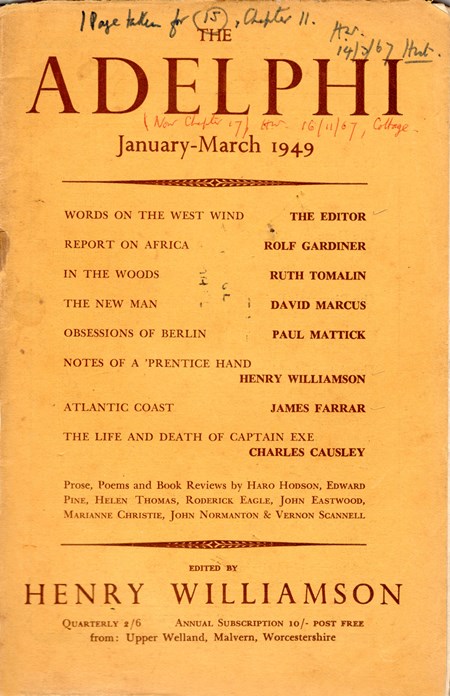
HW now began the first of his editorial essays 'Words on the West Wind' (all of which are reprinted in the collection Words on the West Wind), in which he relates, in easy and charming prose, the story of his sons camping in the Field at Ox's Cross, and how they imitate an owl to call another, and then ending this fun with a cuckoo call: all quite hilarious! It is all typical HW writing, wandering from one subject to another, letting his reader share his world. This ends with a selection of books he has been sent for review.
The issue also includes his 'Notes of a 'Prentice Hand' (reprinted in Words on the West Wind), an autobiographical piece on his early writing days. It is a passage from this essay that the cover MS note refers to, for use in The Gale of the World:
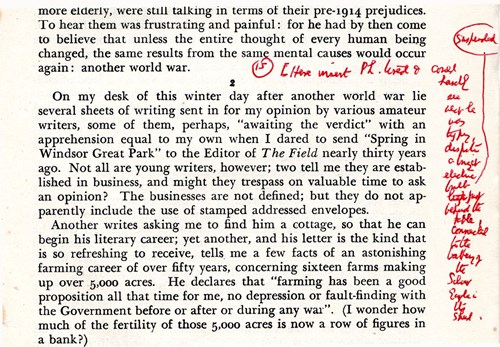
HW's red ink note reads:
15 [Here insert Ph[illip] tired & could hardly see what he was typing despite a bright electric bulb suspended just behind the table, connected to the battery of the Silver Eagle in its shed.'
(This passage in number 15 – the last volume of the Chronicle, The Gale of the World – eventually becomes:
But sleep was broken by perilous thoughts, so he got up; and having connected a long lead from the car battery to a 12-volt bulb suspended from the ceiling, began to scribble rapidly. [p. 169]
And it continues, as Phillip writes:
If there be any young writer, survivor of the Second World War, who aspires to write a War and Peace for this age, to him I send my thoughts this frozen January night.)
There is an important section in 'Notes of a 'Prentice Hand' on what was to be his answer to War and Peace. There is also another essay by James Farrar, 'Atlantic coast' (reprinted in Words on the West Wind).
***************
Vol. 25, No. 2, April–June 1949:
('No. 2' is an error – this was actually No. 3)

Note HW's note: the value seems a little exaggerated!
The contents page has pencilled MS notes indicating the payment made to contributors:

HW's 'Editorial' continues 'Words on the West Wind' and his chatty book reviews – which include Adventure Lit Their Star, Kenneth Allsop's book on the little ringed plover. Allsop, who first met HW in 1935 as a young lad, became a well-known national broadcasting personality in due course. The two men remained friends until Allsop took his own life in 1973, although the relationship was not without some stormy problems.
HW, 'A Note on Tarka the Otter' (reprinted in Words on the West Wind)
This gives 'The Original Ending' to the book.
The item is followed by a poem by Ruth Tomalin, 'Otters Passing'.
***************
Then, as abruptly as he had taken on the magazine and with equally as little background information, HW passed it on to George Godwin (about whom there is no information). But again one can deduce the reasons here.
HW had married Christine Duffield in April 1949 (postponed from January), and they then went on an extended honeymoon visit, mainly staying with Richard Aldington on the south coast of France. This made even a work relationship with Ann Thomas totally untenable. (Ann went on to become a teacher and, after the death of her mother Helen, carried the torch for her father, Edward Thomas, another very troubled man.) Also the work involved on the magazine, even with Ann bearing the basic workload, was considerable – and HW had now embarked (at long last) on the Chronicle of Ancient Sunlight series. He needed all his attention and stamina for that mammoth work, particularly as its birth was attendant with several difficulties, not the least of which was an irrevocable split from his long-standing friend and publisher Richard de la Mare.
Middleton Murry was understandably upset by this abrupt disposal without any consultation with him, for he had entrusted the magazine to HW thinking it would be continued in the same spirit that he had nurtured for those previous twenty-five years. But the magnanimous Murry did not allow this to mar his critical appreciation of the Chronicle in due course. Despite increasing illness, he wrote two long essays of appreciation of HW's work, published posthumously. He died in 1957. (See The Aylesford Review, Vol. 11, No. 2, Winter 1957‒8: 'The Novels of Henry Williamson'; and his longer essay with the same title in Katherine Mansfield and Other Literary Studies, Foreword by T. S. Eliot, Constable, 1959. This latter essay is now available as an e-book, The Novels of Henry Williamson, HWS, 2013.)
***************
Subsequent history of The Adelphi:
Vol. 25, No. 4, July–September 1949:
(Editor, George Godwin)

HW, 'Words on the West Wind' (continued): This episode relates the 1949 honeymoon trip to France noted above.
The issue also contains:
Charles Causley, 'Man into Fox: A note on Henry Williamson as a nature writer', pp. 279-82 (reprinted Words on the West Wind):
. . . no-one, in the history of letters, has written of the English countryside: its sky, its sun, its flowers, its animals (I include the two-legged ones) like this amazing man. . . .
Williamson is a great writer, and more universal, than Richard Jefferies. His prose has the crystal quality, the calm, that one associates with the best of John Clare . . . Williamson sees the world . . . with a child's clear eye.
Ann Thomas has a review section: 'Country Bookshelf'.
The Editor has two articles, notably 'Man on Earth' – and one can sense already a change of tone in the overall content.
***************
Vol. 26, No. 1, Autumn 1949: Autumn Book Number 1949:
HW is still fronting the magazine with the next instalment of 'Words on the West Wind', opening:
The holiday in France could have been a wonderful, had it not been for that damned motorcar. . . .
(This is the 2-litre Aston Martin, bought in Botesdale in 1946, and a constant source of problems! HW's son Richard Williamson gives a brief background to the car as a postscript contained in Words on the West Wind, ‘That Damned Motorcar’.)
There is also a review by HW: Faust, by Von Goethe, translated by Bayard Taylor (Euphorion Books, 12s. 6d.) (reprinted in HWSJ 42, September 2006, p. 37.) This is important with regard to HW's thinking about Goethe, and links to his thought process in general, as explored in AW, 'A Dual Heritage', HWSJ 42, September 2006, pp 5-34.
An advertisement for the book appears on p. 114, and George Godwin, in 'The Common Reader' (pp. 80-7), examines, among others, Albert Schweitzer's address on Goethe at the Frankfurt-am-Maine celebrations, and reproduces a passage from this address on p. 71. All three items were also reprinted in HWSJ 42, September 2006.
I commented in that journal:
There seems to be a pre-destined connection between this upsurge of interest in Goethe (due to the bicentenary anniversary) at the time HW set out on his own odyssey to reflect truly the various aspects of the modern age: A Chronicle of Ancient Sunlight.
George Godwin continued his 'Man on Earth', and started a further long philosophical 'essay': 'The Lake of Memory: A Novel in four Books: (I) The Sacred Ship', pp. 22-63.
***************
Vol. 26, No. 2, January–March 1950:
HW, 'Words on the West Wind' still fronts the magazine. This section, 'Crossing the Alps' ‒ in the Aston Martin ‒ is quite hair-raising! They were en route to see his Italian publisher, Bompiani, in Milan. It ends: (CONCLUDED):

A Faber full-page advertisement, opposite the opening page and HW's essay, includes HW's Scribbling Lark (1949):

Much of the rest of the magazine, some 50+ pages, contains the second part of Godwin's 'The Lake of Memory'. This is followed by 'Book Reviews', including Ann Thomas’s column, 'Country Bookshelf'.
***************
That is the last issue in HW's archive, but the magazine, as stated by The Cambridge Guide to Literature, continued until 1955.
**************************
